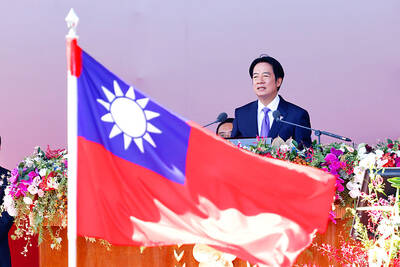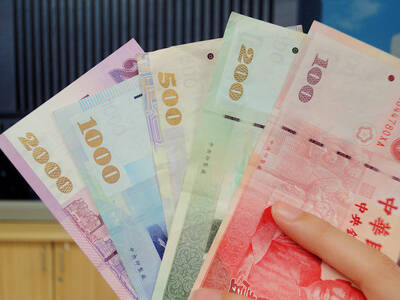The Ministry of Economic Affairs (MOEA) yesterday announced plans to raise electricity rates on all sectors by between 8 and 37 percent to reflect soaring energy costs and curb losses at state-run Taiwan Power Co (Taipower, 台電).
Starting on May 15, electricity prices will rise by an average of 17 percent for households, 30 percent for commercial establishments and 35 percent for industrial users, the ministry said in a report.
“No government in the world can maintain low electricity rates through subsidies for long,” Minister of Economic Affairs Shih Yen-shiang (施顏祥) told a press conference, one day after the ministry’s advisory committee on electricity prices failed to reach a conclusion on the issue.
Taipower would incur NT$10 billion (US$338.83 million) in losses a month if the price adjustments were delayed, Shih said.
The state-owned firm has kept electricity prices unchanged since 2008 and accumulated NT$132.2 billion in net losses as of the end of February, he said.
Currently, electricity costs an average of NT$2.82 per kilowatt hour, while Taipower supplies it at NT$2.6 per kilowatt hour, he said.
Fuel and procurement outlays make up 70 percent of the company’s expenditure, while personnel costs account for 14 percent, Shih said, adding that he was aware of criticism of overgenerous compensation packages for Taipower executives and employees.
“The ministry has set up a task force to review the firm’s salary and procurement policies and all government offices are required to reduce electricity consumption,” Shih said.
Continuing electricity subsidies is both unfair for light users and detrimental to the development of energy conservation, he said.
The new rates are more fair, meaning heavier users incur the highest price hikes, Energy Bureau Director-General Jerry Ou (歐嘉瑞) said.
Under the new rate scheme, electricity prices will stay flat for about 3.65 million households that consume 120 kilowatt hours or less a month, while rates will rise 7.8 percent for 5.66 million households that consume between 120 kilowatt hours and 235 kilowatt hours, the report indicated. For households that consume between 500 kilowatt hours and 620 kilowatt hours per month will see their electricity bills increase by between 16 and 19 percent, the report said.
Electricity rates for households that consume 1,000 kilowatt hours or more a month will rise by 24 percent or more. The progressive rates also apply to commercial establishments, which will see their electricity bills increase by between 16 percent and 33 percent a month depending on the energy they consume, Ou said.
The manufacturing industry will bear the brunt with price rises ranging between 29 and 37 percent, because they are relatively heavy users, the energy official said.
The price hikes are expected to raise overall production costs by 0.48 percent, with electricity bills accounting for about 2.19 percent of the industrial sector’s spending, the report said.
New electicity prices will rise to 6.07 percent of production costs for mineral product makers, from current 4.93 percent, while growing from 1.93 percent to 2.38 percent for electronics makers, the report said.
Electricity outlays will rise to 2.37 percent of production costs for flat-panel makers, from the current 1.92 percent and up from 1.42 percent to 1.75 percent for solar-energy suppliers, the report said.

People can preregister to receive their NT$10,000 (US$325) cash distributed from the central government on Nov. 5 after President William Lai (賴清德) yesterday signed the Special Budget for Strengthening Economic, Social and National Security Resilience, the Executive Yuan told a news conference last night. The special budget, passed by the Legislative Yuan on Friday last week with a cash handout budget of NT$236 billion, was officially submitted to the Executive Yuan and the Presidential Office yesterday afternoon. People can register through the official Web site at https://10000.gov.tw to have the funds deposited into their bank accounts, withdraw the funds at automated teller

PEACE AND STABILITY: Maintaining the cross-strait ‘status quo’ has long been the government’s position, the Ministry of Foreign Affairs said Taiwan is committed to maintaining the cross-strait “status quo” and seeks no escalation of tensions, the Ministry of Foreign Affairs (MOFA) said yesterday, rebutting a Time magazine opinion piece that described President William Lai (賴清德) as a “reckless leader.” The article, titled “The US Must Beware of Taiwan’s Reckless Leader,” was written by Lyle Goldstein, director of the Asia Program at the Washington-based Defense Priorities think tank. Goldstein wrote that Taiwan is “the world’s most dangerous flashpoint” amid ongoing conflicts in the Middle East and Russia’s invasion of Ukraine. He said that the situation in the Taiwan Strait has become less stable

CONCESSION: A Shin Kong official said that the firm was ‘willing to contribute’ to the nation, as the move would enable Nvidia Crop to build its headquarters in Taiwan Shin Kong Life Insurance Co (新光人壽) yesterday said it would relinquish land-use rights, or known as surface rights, for two plots in Taipei’s Beitou District (北投), paving the way for Nvidia Corp to expand its office footprint in Taiwan. The insurer said it made the decision “in the interest of the nation’s greater good” and would not seek compensation from taxpayers for potential future losses, calling the move a gesture to resolve a months-long impasse among the insurer, the Taipei City Government and the US chip giant. “The decision was made on the condition that the Taipei City Government reimburses the related

FRESH LOOK: A committee would gather expert and public input on the themes and visual motifs that would appear on the notes, the central bank governor said The central bank has launched a comprehensive redesign of New Taiwan dollar banknotes to enhance anti-counterfeiting measures, improve accessibility and align the bills with global sustainability standards, Governor Yang Chin-long (楊金龍) told a meeting of the legislature’s Finance Committee yesterday. The overhaul would affect all five denominations — NT$100, NT$200, NT$500, NT$1,000 and NT$2,000 notes — but not coins, Yang said. It would be the first major update to the banknotes in 24 years, as the current series, introduced in 2001, has remained in circulation amid rapid advances in printing technology and security standards. “Updating the notes is essential to safeguard the integrity